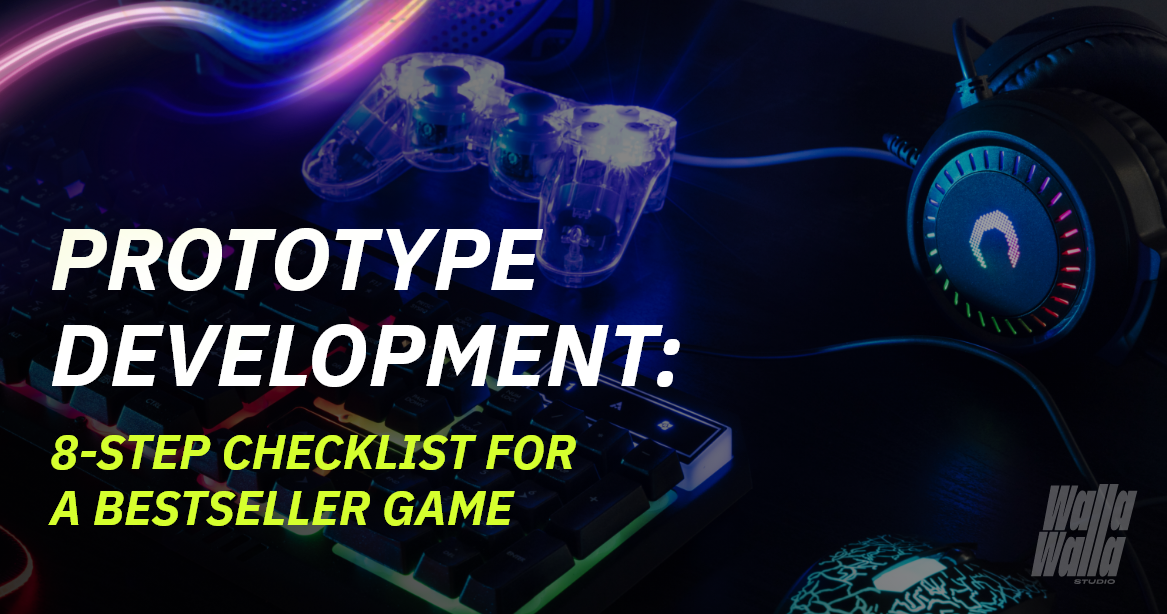 Search
Search

Let’s imagine you’ve played some game, you adore it a lot, and you have an idea of developing something very close to it, but even better.
If you’re here, you already know, that first of all, you’ll need a game design document and a game prototype.
Developing a game prototype is a complex and creative process that requires careful consideration of various aspects to ensure your game’s triumph.
We’re preparing game design documents and doing a lot of game prototyping for our clients, but in case you prefer a do-it-yourself approach, we’ve compiled essential checkpoints to consider during your prototyping process. So you can maximize your chances of success with our expert guidance and comprehensive checklist.
Drawing inspiration from Jesse Schell‘s influential book, “The Art of Game Design: A Book of Lenses,” (which we truly admire) and Walla Walla Studio’s vast game development experience, we will now delve into the questions:
- What are your game’s selling points?
- Who is your target audience?
- Which competitive advantages of your game will distract players from other games?
- Why should players switch to your game now? Is the time of the planned release chosen correctly?
- What is the emotional impact of your game?
- What is the player cost for your game?
- What is the cost of player delays?
- How to effectively spend your game prototype budget when it’s limited?
1. What are your game’s selling points?
“Unique selling points are our studio’s focuses in game prototyping. You can design a game with superior graphics and ideas but it still won’t be downloaded by people because it has no selling points for your audience. That’s why this question is the first and the most crucial.
We use all our game development and art development experience to find the selling points which will allow you to sell your game efficiently with fewer resources spent”, – comments Walla Walla Studio’s game producer, Igor.
There are basically 4 aspects, which you need to form the selling points for:
- the game’s uniqueness – you need to identify what makes your game concept unique compared to existing games. Explore innovative mechanics, gameplay twists, or novel approaches to captivate players and differentiate your game;
- emotion – it’s all about crafting selling points that evoke specific emotions in players. Determine the desired emotional impact, whether it’s excitement, joy, curiosity, or tension, and integrate gameplay elements, narratives, or visuals that effectively call for those emotions;
- appeal – analyze what aspects of your game have the potential to attract and engage players. Focus on key features, visual aesthetics, unique challenges, or social interactions that create a strong appeal and drive interest;
- player – сonsider your target audience’s desires, preferences, and motivations. Tailor your selling points to resonate with their needs, offering an experience that fulfills their expectations and stands out in the market.
2. Who is your target audience?
When you start thinking of your potential players, this question automatically arises. If you have difficulties at this stage, we advise turning to Jesse Schell’s methodology. It helps to see your audience after looking through 4 lenses:
1. The Lens of the Demographic
Here you should analyze the demographic characteristics of your potential players, such as:
- age,
- gender,
- and location.
Consider how these factors influence their gaming preferences and tailor your game’s selling points accordingly.
For example, if the target audience consists primarily of younger players, the selling points may focus on engaging visuals, fast-paced gameplay, and social interaction.
On the other hand, if the target audience is more mature, the selling points may emphasize immersive storytelling, strategic decision-making, or challenging gameplay.
2. The Lens of the Motivation
Explore the motivations that drive players to engage with games. Are they seeking competition, social interaction, exploration, or relaxation? Clarifying these motivations will help to align your game’s features and experiences with what your target audience desires.
3. The Lens of the Experience
You should take into account the expected experience and skill level of your target audience. Are they casual gamers, hardcore enthusiasts, or novices?
Create challenges, gameplay mechanics, and progression systems that align with their skill levels. Still ensuring an immersive and captivating experience tailored to their abilities.
4. The Lens of the Persona
Creating detailed personas that represent your target audience segments will help to better understand the needs of your audience.
For example, your persona #1 is Sarah. She is 28, a graphic designer from an urban area. What are her motivations in your game? What are her game preferences? And what are her global goals which your game helps to reach?
This way you can describe the main persona types of your audience to make informed design decisions and create experiences that resonate with their specific needs.
3. Which competitive advantages of your game will distract players from other games?
The competitive advantages of a game and the selling points of a game seem to be related but still, these are distinct concepts. Competitive advantages contribute to your game’s selling points, helping to differentiate it from other games and enhance its market position.
What can you do to make sure players spend time with your game instead of others? The answers are your competitive advantages. They highlight what makes the game stand out from others in terms of quality, features, or market positioning. These advantages provide a comparative edge over similar games, attracting players and creating a unique value proposition.
Your game’s competitive advantages may include factors such as advanced technology, superior graphics, innovative gameplay mechanics, exceptional multiplayer features, or exclusive partnerships.
4. Why should players switch to your game now? Is the time of the planned release chosen correctly?
Timing is very important, as Schell notes. If your prototype offers fresh and exciting experiences or fills a gap in the market, launching at the right time can drive player engagement and prompt them to switch to your game.
You need to know that potentially incorrect times for a game release are:
- oversaturated period – when the market is flooded with highly anticipated game launches;
- significant competitor release – if a highly anticipated game from a major competitor is scheduled for release around the same time, it may be wiser to adjust the release date to avoid being overshadowed;
- technical issues and unfinished state – can result in a poor player experience and negative reviews;
- lack of marketing and promotion – it simply limits a game’s visibility and reach.
5. What is the emotional impact of your game?
What emotions do you want players to experience when playing your game? Deliberately crafting emotions like excitement, tension, joy, or curiosity through gameplay mechanics, narrative elements, art direction, and audio can significantly enhance the player experience. Consider forming these emotional aspects from the early stages of prototyping to create a captivating and immersive game.
For example:
- challenging gameplay can generate a sense of accomplishment and satisfaction, while exploration mechanics can evoke curiosity and wonder. Balancing difficulty, pacing, and player agency in gameplay can influence emotional responses;
- visually striking graphics, atmospheric environments, dynamic lighting, and expressive character animations can enhance immersion;
- a carefully crafted soundtrack, sound effects, and voice acting can intensify emotions and create a deeper emotional connection with players.
Engaging in cooperative or competitive gameplay with other players can intensify the emotional experience and create a sense of social connection. And allowing players to make choices that impact the game’s narrative can create a sense of agency and emotional investment.
6. What is the player cost for your game?
How much will it cost you to acquire and retain a player? Here you’ll need to analyze marketing expenses, user acquisition costs, and ongoing support and maintenance to determine the financial viability of your prototype.
Step 1: identify the marketing channels through which you plan to acquire players.
We suggest using social media advertising, influencer partnerships, app store promotions, and search engine marketing.
Step 2: estimate costs per channel.
Now you need to research the average costs associated with each user acquisition channel you’ve chosen (marketing experts, reviewing industry benchmarks, or reaching out to advertising platforms for estimates).
Step 3: set acquisition goals.
Determine the number of new players you aim to acquire during the prototype phase. Please, establish realistic targets based on your marketing budget and the size of your target audience.
Step 4: calculate total costs.
To get the total, multiply the estimated cost per acquisition from each channel by the number of new players you intend to acquire through that channel. Then sum up these figures to get an estimate of the total user acquisition costs.
Step 5: account for retention.
Remember that user acquisition is not solely about attracting players; it’s also about retaining them. Factor in additional costs associated with player engagement, community management, and support to ensure a holistic view of the acquisition process.
So, now you have a reasonable estimation of whether the players’ acquisition cost justifies the revenue they are expected to generate.
7. What is the cost of player delays?
You should also think of a case when production delays or poor game design may cause delays for players to your game. This can lead to missed marketing opportunities, increased competition, and a loss of player interest.
It’s better not to let that situation happen. Efficient project management, realistic development timelines, and regular communication with players are crucial to minimize delays and optimize your success.
8. How to effectively spend your game prototype budget when it’s limited?
“It’s a common thing when you wish to plan this and that for your game, but it seems like the limited budget can’t allow you everything. It doesn’t mean you need to give up something.
For our clients, we always find a way to maintain a balance between resource allocation and game mechanics testing” – says Igor, Walla Walla Studio’s game producer.
Efficiently allocating the budget to accomplish all tasks is a mark of professionals. Only skilled game developers can balance budgetary constraints to bring all your ideas to life. That’s why it is wise to delegate your game prototyping to Walla Walla Studio experts.
We’ll prioritize the core features of your game, mechanics, and elements that align with your game’s vision and unique selling points.
Summing it up
Developing a successful game prototype requires careful consideration of various aspects to ensure its success. By defining selling points, understanding the target audience, identifying competitive advantages, and choosing the right time for release, you can maximize player engagement in your future game.
Additionally, considering the emotional impact, player cost, and effective budget allocation will help you to create an enticing and immersive gaming experience.
Whether you seek professional game development assistance or prefer a do-it-yourself approach, implementing these strategies will enhance your chances of success in the competitive gaming landscape.


